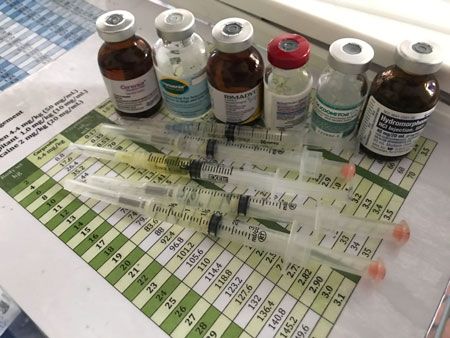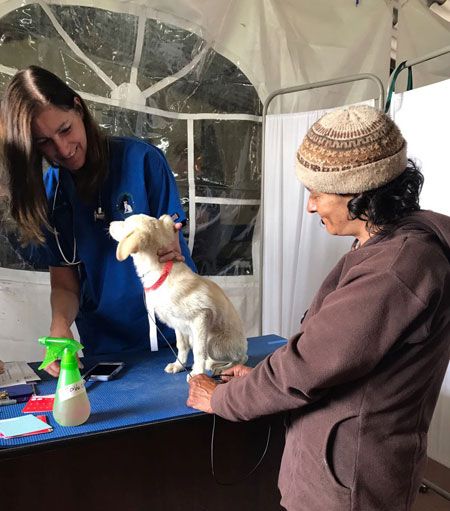The dogs of Otavalo
Veterinary professionals band together to help hundreds of street dogs in Ecuador in need of care.

Sometimes feelings of helplessness can paralyze us, and sometimes they can propel us forward. For Azadeh ‘Azi' Chegini, it was the latter. In April 2016, Chegini was visiting the home of friends in Otavalo, Ecuador. Chegini came across a street dog with two broken legs-and it seemed as though this poor dog had been sitting on the side of the road for days. She was in great pain but too weak to move or make noise.
Chegini took the dog into her arms and made a promise that she would come back to Ecuador with help. The dog was left with animal protection in the city of Quito as Chegini boarded a plane back to the United States. On that flight back to Virginia, the organization The Dogs of Otavalo was born. Chegini, a Zoetis Pharmaceutical rep in the Virginia area, was determined to return to Otavalo with an army of veterinary professionals, including veterinarians, technicians and others to help the forgotten street dogs.

Nestled between two volcanos in the Andean Highlands, Otavalo is a blanket of dewy green surrounded by clouds; the air smells of eucalyptus and sweet water. Cobblestone roads traverse the hilly countryside and are flanked by stone houses and farms. Chickens, hogs and cattle dot the lush knolls. Dogs are abundant. Many of them live with the very poor local families, many of whom are farmers who feed and give them shelter. But many other dogs are homeless. As is true in many underdeveloped countries, street dogs are abundant, and only the smartest survive.
Back in Virginia, Chegini began planning her next trip to help the dogs of Ecuador. She formed alliances with organizations like CHASE, a nonprofit dedicated to increasing awareness of and providing support for animal welfare initiatives, and Amici Cannis, a nonprofit with a mission to help provide funding, medical equipment, supplies and educational materials to animal welfare organizations in the country of Ecuador.
Chegini began recruiting volunteers and formulating a plan to make this project a reality. A fund was set up for donations, and the volunteer team began reaching out to their friends, colleagues and industry contacts for donations of money and supplies.

Simultaneously, in Otavalo, a number of volunteers began work to establish the project there. This was no small task, and it involved the work of the local government, veterinarians, innkeepers, cooks and project volunteers. After many meetings, a building was secured, permits obtained and arrangements were made to house, feed and transport the American volunteers when they arrived.
Local volunteers gathered the community to educate them about the project. They talked about the importance of spaying and neutering and vaccinating pets. Then they helped make appointments for more than 200 local dogs and cats, along with a number of street dogs.

The goal was to provide high-quality care to at least 300 dogs and cats over six days. Physical exams, spay/neuter, deworming and vaccinations topped the list. Volunteers would need to carry more than 3,000 pounds of supplies and equipment from the United States in checked luggage to turn an old concrete community center building into a fully functioning animal hospital.
One of the objectives was to start building relationships with the communities of Otavalo and neighboring Cotacachi, so that ongoing care could be established, as well as basic client education. The residents of Otavalo welcomed the volunteers with open arms, scrubbing the building, helping translate, cooking traditional Ecuadorian food for lunch each day and watching over the supplies at night.

One aspect that was so unique about this mission was the quality of anesthesia and pain management provided, thanks to two International Veterinary Academy of Pain Management (IVAPM) board member volunteers. The anesthetic protocols and the level of care provided was unique compared to what is typically practiced in under-developed areas of the world. The group was fortunate enough to have had generous donations of drugs and supplies from companies like Zoetis South America, Sentier and Patterson Veterinary Supply. The veterinary team saw nearly 60 cases each day.

Every patient was examined by a veterinarian and then premedicated with dexmedetomidine and hydromorphone intramuscularly, followed by subcutaneous injections of Rimadyl and Convenia. Once sedate, the animal was transported to the induction room. Here, an IV catheter was placed, and each patient received Cerenia intravenously, and was then induced with ketamine intravenously. Higher risk patients were intubated, while others were kept on supplemental oxygen with a homemade mask. Four surgeries were performed simultaneously, and each patient received oxygen from one oxygen concentrator and one anesthesia machine donated by Patterson Veterinary Supply. The machine was set up as an “oxygen bar” by piping oxygen from the fresh gas outlet and splicing it to feed four stations.

Once on the table, patients were connected to a constant rate infusion of hydromorphone and ketamine to help keep them anesthetized and under proper analgesia during surgery. They were monitored using the Sentier Vetcorder pulse oximeter and ECG as well as the Massimo EMMA end-tidal carbon dioxide monitor. Volunteers also provided direct palpation of pulses, chest auscultation and mucous membrane color evaluation. Local anesthesia was used when appropriate for incisional and intratesticular blocks.

After surgery, patients were returned to the recovery area downstairs and monitored continuously until awake. Once alert and of normal body temperature, all patients were injected with rabies and other species-specific vaccines. Patients were dewormed and treated for external parasites. When they were alert enough to go home, they were reunited with their families, most of whom had waited all day at the facility.

On the third day of the clinic, the team focused on altering the street dogs that were rounded up and brought in by the fearless and dedicated volunteers in Otavalo. There was concern that the street dogs would be difficult to work with, but the opposite was true; the street dogs were the easiest group to work with and seemed to respond well to affection.
Along with the spaying and neutering of dogs, volunteers also brought in an injured dog with a forelimb degloving injury that appeared to be days old. The dog was clearly withdrawn and in pain. Chegini and the team of veterinary volunteers committed to helping this small, fluffy female dog. Plans were made to transfer the dog to the nearest veterinary hospital in Cotacachi, run by Amici Cannis. The dog was given analgesics, then wrapped in a fleece blanket and driven to the clinic, where she would receive the care she needed.
Amici Cannis is a full-service veterinary hospital located at the foot of the dormant Cotacachi volcano. Like Otavalo, there is a surplus of street dogs, some sick or injured, and all are intact.
After six long days, a group of 30 veterinary professionals had spayed and neutered nearly 300 dogs and 10 cats and made a small step toward controlling the street dog population in these municipalities. They also made an impact in the communities they touched, received so much in return and made friendships that will last a lifetime.

The small, fluffy female dog with the degloving injury required a forelimb amputation. But despite losing a limb, she gained a family. Arrangements were made to fly “Mojandita” back to the United States to live with Chegini, paying tribute to the first dog she encountered that sparked this whole adventure.
Note: The founding directors of The Dogs of Otavalo have now formed a 501(c)(3) charitable organization to allow continuation of this work long into the future. The next Dogs of Otavalo campaign is scheduled for January 2018.
For more information about Dogs of Otavalo and other projects please visit the eagleYcondor foundation at www.eagleYcondor.org
Kristen Cooley, BA, CVT, VTS (anesthesia), is an instructional specialist at the University of Wisconsin School of Veterinary Medicine and a consultant in Veterinary Anesthesia Support and Training.











